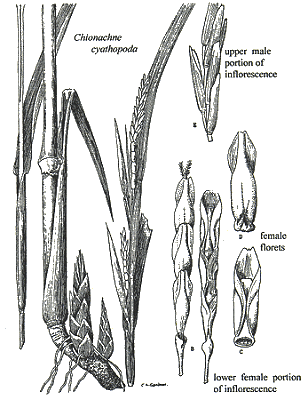 |
 |
|
 |
 |
|

Chionachne cyathopoda (F.Muell.) F.Muell. ex Benth. |
Common name
River Grass
Derivation
Chionachne R.Br., in J.J.Bennett & R.Brown, Pl. Jav. Rar. 15 (1838);
from the Greek chion (snow) and achne (chaff), in allusion to
the pale coloured glumes of some species.
cyathopoda- from the Greek kyathos (cup) and pous (foot). Apex of peduncle is cup-shaped.
Published in
Fl. Austral. 7: 516 (1878).
Habit
Perennial, tufted. Rhizomes elongated, scaly. Culms erect, reed-like, 200–400
cm tall. Mid-culm internodes channelled. Mid-culm nodes glabrous or pubescent.
Lateral branches simple or sparsely branched. Leaves cauline. Ligule a fringed
membrane, 1–1.5 mm long, membranous. Leaf-blades 13–60 cm long, 10–30
mm wide. Leaf-blade margins cartilaginous, spinulose. Leaf-blade apex acuminate.
Monoecious, with male and female spikelets in the same inflorescence.
Inflorescence
Inflorescence terminal and axillary, subtended by a
spatheole, enclosed. Rames single, 6–12 cm long, bearing a few fertile
spikelets. Rhachis fragile at the nodes. Rame internodes linear, bearing a
sterile companion laterally. Rame internode tip transverse, crateriform. Sexes
segregated, on bisexual branches, with male above.
Spikelets
Spikelets embracing internode, in pairs, one sessile and fertile and the other
(companion) spikelet pedicelled. Male spikelets sessile and pedicelled, 2 in
a cluster. Pedicels of companion sterile spikelets fused to internode, united
wholly. Companion spikelets rudimentary, 1 mm long. Fertile spikelets 2-flowered,
comprising 1 fertile floret, without rhachilla extension, oblong, dorsally compressed,
15 mm long, 4 mm wide, falling entire, deciduous with accessory branch structures.
Spikelet callus base truncate, with central peg, attached transversely.
Glumes
Glumes dissimilar, firmer than fertile lemma. Lower glume ovate, 15 mm long,
100% of length of spikelet, indurate, pallid, 2-keeled, keeled laterally,
winged on keel, winged above. Lower glume surface not waisted. Lower glume apex
obtuse. Upper glume ovate, cartilaginous. Upper glume apex acuminate or cuspidate.
Florets
Basal sterile floret 1, without significant palea. Lemma of lower sterile floret
ovate, hyaline, 3-nerved. Fertile florets female. Fertile lemma lanceolate,
8–12 mm long, hyaline, 1-nerved. Lemma lateral nerves obscure. Lemma apex
acute. Palea 100% of length of lemma, hyaline or membranous, 2-nerved. Anthers
3, 2.5–5 mm long. Male spikelets distinct from female, with pedicels fused
to rhachis, 2-flowered, lanceolate, 12–13 mm long. Male spikelet glumes
2, 10–12-nerved. Male spikelet lemma 0–3-nerved.
Continental Distribution:
Tropical Asia, Australasia.
Australian Distribution:
Western Australia, Northern Territory, Queensland.
Western Australia: Gardner, Fitzgerald, Dampier. Northern Territory: Darwin & Gulf, Victoria River, Barkly Tableland. Queensland: Cook, Burke, North Kennedy, South Kennedy, Port Curtis, Leichhardt, Burnett, Wide Bay, Darling Downs, Moreton.
Classification. (GPWG
2001):
Panicoideae: Andropogoneae
Notes
Nitive to New Guinea and tropical W.A., N.T. and Qld to subtropical Qld. Found
on stream banks or wetter sites on sandy or loamy soils. Eaten to some extent
by stock, although coarse. Flowers all year but mainly Feb.–July.

Habit and details (line drawing)
© Gardner 1952